Bacteria Shakers
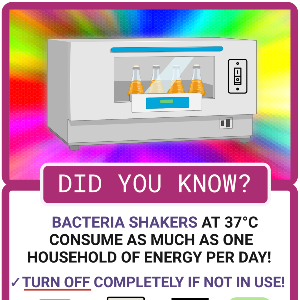
© Green Lab Initiative BMC
January 2023
The facts
Standard bacteria shakers consume up to 5.5 kWh per day just to maintain the device at 37°C. This is as much energy as a one-person household in Germany consumes per day.
What we can do
- Since the shakers may not be frequently needed and it only takes about 20 minutes to warm up to 37°C after switching on, we can avoid unnecessary energy consumption by switching them off by default and only turning them on when needed.
- In addition: Let's share incubators whenever possible.
1. Energy consumption of bacteria shakers:
Green light laboratories, 2019
2. Energy consumption of households in Germany:
Statistisches Bundesamt, 2020
Download posterGreen Fact Bacteria Shakers (PDF, 293 KB)
BioRender.com
Cell culture hoods
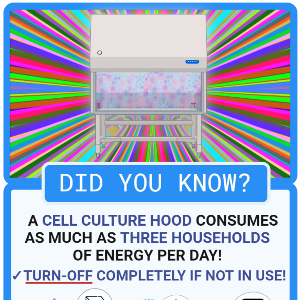
© Green Lab Initiative BMC
February 2023 (edited March 2023)
The facts
Cell culture hoods are essential for the safety of users and biological materials; however, they contribute massively to the energy consumption of laboratories due to the constant maintenance of air temperature and flow.
What we can do
- Close and turn off cell culture hoods after use.
- 1. Energy consumption of biological safety cabinets - NIH environmental management system newsletter, 2021; List of metered equipment CU Green Labs, University of Colorado Boulder, 2018; Calculation energy consumption biological safety cabinet at BMC (PDF, 363 KB)
Download poster Green Fact Cell Culture Hood (PDF, 1.131 KB)
BioRender.com
Freezer temperatures
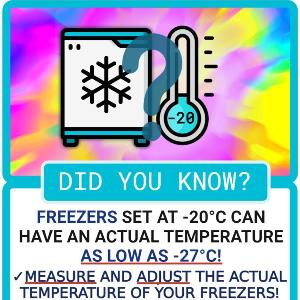
© Green Lab Initiative BMC
May 2023
The facts
Freezers can be colder than their set temperature. At the BMC, freezers set at -21°C were observed to be at temperatures as low as -27°C. The lower the actual temperature of a freezer, the more energy it consumes.
What we can do
- To prevent unnecessary cooling and ensure appropriate sample storage, measure the freezer temperature with a thermometer and adjust the freezer settings accordingly.
Download poster Green Fact Freezer Temperatures (PDF, 390 KB)
BioRender.com
Freezer icons created by Smashicons - Flaticon; Freezer icons created by Freepik - Flaticon; Cold icons created by Freepik - Flaticon; Thermometer icons created by Freepik - Flaticon; Defrost icons created by Freepik - Flaticon; Low temperature icons created by IconBaandar - Flaticon; Defrost icons created by Freepik - Flaticon; Freezing icons created by Freepik - Flaticon
Freezer organization
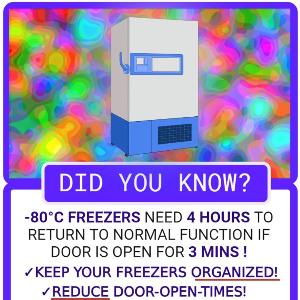
© Green Lab Initiative BMC
June 2023
The facts
Fridges and freezers warm up upon opening and require longer to recover back to the set temperature when opened for longer! At the BMC, an ultra-low-temperature (ULT) freezer at –80°C required 4 hours to return to its set temperature after being opened for 3 accumulative minutes.
What we can do
- Keep your fridges and freezers organized.
- Reduce opening time of fridges’ and freezers’ doors.
- When searching for samples in a box, take the box out and close the fridge/freezer door. Use (dry) ice when necessary.
Download poster Freezer Organization (PDF, 384 KB)
Biorender.com
Stand-by mode
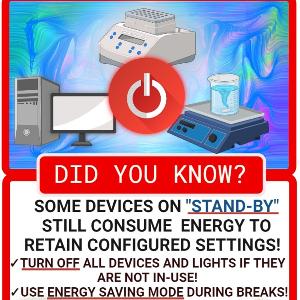
© Green Lab Initiative BMC
August 2023
The facts
Some bench-top devices (eg. heaters, shakers, centrifuges, computers) still consume energy on “stand by” in order to maintain the set-temperature and display. Each individual device may not consume a lot of energy alone, but it adds up over time and in mass.
What we can do
- Turn devices completely off when they are not “in-use”. In general, please remember to turn devices and room lights off when not in-use.
- Set computers to hibernate or “energy saving mode” during breaks.
Download poster Stand-By Mode (PDF, 439 KB)
Biorender.com
Ultra-low temperature freezers
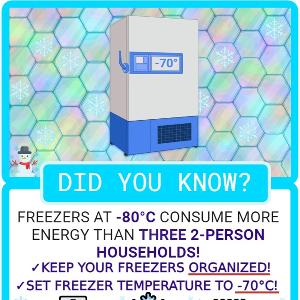
© Green Lab Initiative BMC
December 2023
The facts
One ultra-low temperature freezer at -80°C uses about 11,000 kWh/year1, which is over three times more than the energy consumed by a 2-person household (3,221 kWh/year)2. While their function in the laboratory setting cannot be replaced, there are some actions we can take to reduce their energy consumption and prolong their lifetime.
What we can do
- Reduce the number of freezers in use by consolidating the items stored.
- Reduce the freezer’s open-time (see Green Fact “Freezer organization”).
- Regularly defrost the freezers and remove ice buildup.
- Regularly vacuum the condenser filter and coils to ensure efficient cooling.
- Turn the freezers to -70°C to cut energy use by 30%3. Not sure whether -70°C is safe for your samples? Check here for more information.
1. Energy consumption ultra-low temperature freezers (PDF)
2. Energy consumption of households in Germany (accessed Dec 2023)
3. "-70 is the new -80", My Green Lab
Download poster Ultra-Low Temperature Freezer (PDF, 404 KB)
Biorender.com
